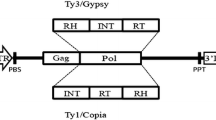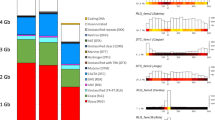Abstract
Four previously undescribed families of miniature inverted repeat transposable elements (MITEs) were isolated by searching barley genomic DNA using structure-based criteria. Putative MITEs were confirmed by PCR to determine their insertional polymorphism in a panel of diverse barley germplasm. Copy numbers for all these familes are somewhat low (less than 1,000 copies per family per haploid genome). In contrast to previous studies, a higher proportion of insertions of the new MITEs are found within known transposable elements (27%) than are associated with genes (15%). Preliminary studies were conducted on two of the new MITE families to test their utility as molecular markers. Insertional polymorphism levels for both the families are high and diversity trees produced by both the families are similar and congruent with known relationships among the germplasm studied, suggesting that both the MITE families are useful markers of barley genetic diversity.




Similar content being viewed by others
Abbreviations
- MITE:
-
Miniature inverted repeat transposable element
- TE:
-
Transposable element
- SSAP:
-
Sequence-specific amplification polymorphisms
- IRAP:
-
Inter-repeat amplification polymorphisms
- TIR:
-
Terminal inverted repeat
- TSD:
-
Terminal sequence duplication
- AFLP:
-
Amplified fragment length polymorphism
- BAC:
-
Bacterial artificial chromosome
- TBE:
-
TRIS–borate–EDTA
References
Badr A, Muller K, Schafer-Pregl R, El Rabey H, Effgen S, Ibrahim HH, Pozzi C, Rohde W, Salamini F (2000) On the origin and domestication history of Barley (Hordeum vulgare). Mol Biol Evol 17:499–510
Braquart C, Royer V, Bouhin H (1999) DEC: a new miniature inverted-repeat transposable element from the genome of the beetle Tenebrio molitor. Insect Mol Biol 8:571–574
Bender B, Kleckner N (1986) Genetic evidence that Tn10 transposes by a nonreplicative mechanism. Cell 45:801–815
BioEdit biological sequence alignment editor for Windows (1997) http://www.mbio.ncsu.edu/BioEdit/BioEdit.html
Bureau TE, Wessler SR (1992) Tourist–a large family of small inverted repeat elements frequently associated with maize genes. Plant Cell 4:1283–1294
Bureau TE, Wessler SR (1994a) Stowaway—a new family of inverted repeat elements associated with the genes of both monocotyledonous and dicotyledonous plants. Plant Cell 6:907–916
Bureau TE, Wessler SR (1994b) Mobile inverted-repeat elements of the tourist family are associated with the genes of many cereal grasses. Proc Natl Acad Sci USA 91:1411–1415
Casa AM, Brouwer C, Nagel A, Wang L, Zhang Q, Kresovich S, Wessler SR (2000) The MITE family heartbreaker (Hbr): molecular markers in maize. Proc Natl Acad Sci USA 97:10083–10089
Casa AM, Mitchell SE, Smith OS, Register JCIII, Wessler SR, Kresovich S (2002) Evaluation of Hbr (MITE) markers for assessment of genetic relationships among maize (Zea mays L.) inbred lines. Theor Appl Genet 104:104–110
Chang RY, O’Donoughue LS, Bureau TE (2001) Inter-MITE polymorphisms (IMP): a high throughput transposon- based genome mapping and fingerprinting approach. Theor Appl Genet 102:773–781
Fedoroff N (1989) In: Howe M, Berg D (eds) Mobile DNA. Am Soc Microbiol, Washington, DC, pp 375–411
Feschotte C, Mouches C (2000) Evidence that a family of miniature inverted-repeat transposable elements (MITEs) from the Arabidopsis thaliana genome has arisen from a pogo-like DNA transposon. Mol Biol Evol 17:730–737
Jiang N, Wessler SR (2001) Insertion preference of maize and rice miniature inverted repeat transposable elements as revealed by the analysis of nested elements. Plant Cell 13:2553–2564
Jing R, Knox MR, Lee JM, Vershinin AV, Ambrose MJ, Ellis THN, Flavell AJ (2005) Insertional polymorphism and antiquity of PDR1 retrotransposon insertions in Pisum species. Genetics 171:741–752
Kalendar R, Grob T, Regina M, Suoniemi A, Schulman A (1999) IRAP and REMAP: two new retrotransposon-based fingerprinting techniques. Theoret Appl Genet 98:704–711
Langdon T, Jenkins G, Hasterok R, Neil Jones R, King IP (2003) A high-copy number CACTA family transposon in temperate grasses and cereals. Genetics 163:1097–1108
Larkin MA, Blackshields G, Brown NP, Chenna R, McGettigan PA, McWilliam H, Valentin F, Wallace IM, Wilm A, Lopez R, Thompson JD, Gibson TJ, Higgins DG (2007) ClustalW and ClustalX version 2. Bioinformatics 23:2947–2948
Le Quang H, Wright S, Yu ZH, Bureau T (2000) Transposon diversity in Arabidopsis thaliana. Proc Nat Acad Sci USA 97:7376–7381
Lepetit D, Pasquet S, Olive M, Theze N, Thiebaud P (2000) Glider and vision: two new families of miniature inverted-repeat transposable elements in Xenopus laevis genome. Genetica 108:163–169
Madishetty K, Condamine P, Svensson JT, Rodriguez E, Close TJ (2007) An improved method to identify BAC clones using pooled overgos. Nucleic Acids Res 35:e5–e7
Mao L, Wood TC, Yu Y, Budiman MA, Tomkins J, Woo S, Sasinowski M, Presting G, Frisch D, Goff S et al (2000) Rice transposable elements: a survey of 73, 000 sequence-tagged- connectors. Genome Res 10:982–990
NCBI Expressed Sequence Tags Database (1993) http://www.ncbi.nlm.nih.gov/projects/dbEST/
Nakazaki T, Okumoto Y, Horibata A, Yamahira S, Teraishi M, Nishida H, Inoue H, Tanisaka T (2003) Mobilization of a transposon in the rice genome. Nature 421:170–172
Park KC, Kim NH, Cho YS, Kang KH, Lee JK, Kim N-S (2003) Genetic variations of AA genome Oryza species measured by MITE-AFLP. Theor Appl Genet 107(2):203–209
Phylip phylogeny inference package (1980) http://evolution.genetics.washington.edu/phylip.html
Rice P, Longden I, Bleasby A (2000) EMBOSS: the European molecular biology open software suite. Trends Genet 16:276–277
Rostoks N, Schmierer D, Mudie S, Drader T, Brueggeman R, Caldwell D, R, Kleinhofs A (2006) Barley necrotic locus nec1 encodes the cyclic nucleotide-gated ion channel 4 homologous to the Arabidopsis HLM1. Mol Genet Genomics 275:159–168
Rozen S, Skaletsky HJ (2000) Primer3 on the WWW for general users and for biologist programmers. In: Krawetz S, Misener S (eds) Bioinformatics methods and protocols: methods in molecular biology. Humana Press, Totowa, NJ, pp 365–386
Schulman AH, Kalendar R (2005) A movable feast: diverse retrotransposons and their contribution to barley genome dynamics. Cytogenet Genome Res 110:598–605
Shapiro J (1979) A molecular model for the transposition and replication of bacteriophage Mu and other transposable elements. Proc Nat Acad Sci USA 76:1933–1937
Song WY, Pi LY, Bureau TE, Ronald PC (1998) Identification and characterization of 14 transposon-like elements in the noncoding regions of members of the Xa21 family of disease resistance genes in rice. Mol Gen Genet 258:449–456
Syed N, Sundar S, Wilkinson M, Bhau B, Cavalcanti J, Flavell AJ (2005) Ty1-copia retrotransposon-based SSAP marker development in Cashew (Anacardium occidentale L.). Theor Appl Genet 110:1195–1202
Syed NH, Flavell AJ (2007) Sequence specific amplification polymorphisms (SSAP) - a multi-locus approach for analysing transposon insertions. Nat Protoc 1:2746–2752
Tatout C, Warwick S, Lenoir A, Deragon J-M (1999) SINE insertions as clade markers for wild crucifer species. Mol Biol Evol 16:1614–1621
Triticeae Repeat Database (2000) In GrainGenes http://wheat.pw.usda.gov/ggpages/oatCoP.html (17 Nov. 2000).
Turcotte K, Srinivasan S, Bureau T (2001) Survey of transposable elements from rice genomic sequences. Plant J 25:169–179
Verhoeven KJF, Vanhala TK, Biere A, Nevo E, Van Damme JMM (2004) The genetic basis of adaptive population differentiation: a quantitative trait locus analysis of fitness traits in two wild barley populations from contrasting habitats. Evolution 58:270–283
Volis S, Yakubov B, Shulgina I, Ward D, Mendlinger S (2005) Distinguishing adaptive from nonadaptive genetic differentiation: comparison of Qst and Fst at two spatial scales. Heredity 95:466–475
Vos P, Hogers R, Bleeker M, Reijans M, van de Lee T, Hornes M, Fritjers A, Pot J, Peleman J, Kuiper M, Zabeau M (1995) AFLP: a new concept for DNA fingerprinting. Nucleic Acid Res 23:4407–4414
Waugh R, McLean K, Flavell AJ, Pcarce SR, Kumar A, Thomas BB, Powell W (1997) Genetic distribution of Bare-1-like retrotransposable elements in the barley genome revealed by sequence-specific amplification polymorphisms (S-SAP). Mol Gen Genet 253:687–694
Wicker T, Guyot R, Yahiaoui N, Keller B (2003) CACTA transposons in Triticeae. A diverse family of high-copy repetitive elements. Plant Physiol 132:52–63
Yang GJ, Hall TC (2003) MDM-1 and MDM-2: two mutator-derived MITE families in rice. J Mol Evol 56:255–264
Yant SR, Meuse L, Chiu W, Ivics Z, Izsvak Z, Kay MA (2000) Somatic integration and long-term transgene expression in normal and haemophilic mice using a DNA transposon system. Nature Rev Genet 25:35–41
Yu Y, Tomkins JP, Waugh R, Frisch DA, Kudrna D, Kleinhofs A, Brueggeman RS, Muehlbauer GJ, Wise RP, Wing RA (2000) A bacterial artificial chromosome library for barley (Hordeum vulgare L.) and the identification of clones containing putative resistance genes. Theor Appl Genet 101:1093–1099
Zhang Q, Arbuckle J, Wessler SR (2000) Recent, extensive, and preferential insertion of members of the miniature inverted-repeat transposable element family Heartbreaker into genic regions of maize. Proc Natl Acad Sci USA 97:1160–1165
Zhang X, Feschotte C, Zhang Q, Jiang N, Eggleston WB, Wessler SR (2001) P instability factor: an active maize transposon system associated with the amplification of Tourist-like MITEs and a new superfamily of transposases. Proc Natl Acad Sci USA 98:12572–12577
Acknowledgments
We are grateful to Ali Massoudi, Luke Ramsay, Katie Caldwell and Tim Close for supplying unpublished barley DNA sequence for this study and Alan Schulman for helpful comments. This work was financially supported by a BBSRC PhD studentship to ML. We are also grateful for technical support and advice from Sharon Mudie.
Author information
Authors and Affiliations
Corresponding author
Additional information
Communicated by M.-A. Grandbastien.
Sequence data from this article have been deposited with the EMBL/GenBank Data Libraries under accession nos. EU822304–EU822308.
Electronic supplementary material
Below is the link to the electronic supplementary material.
438_2008_363_MOESM1_ESM.doc
Supplementary Fig. 1. An example of an autoradiograph from copy number screens of a barley BAC genomic clone library using Talisker overgo probe. Positive clones correspond to adjacent double spots (DOC 98 kb)
Rights and permissions
About this article
Cite this article
Lyons, M., Cardle, L., Rostoks, N. et al. Isolation, analysis and marker utility of novel miniature inverted repeat transposable elements from the barley genome. Mol Genet Genomics 280, 275–285 (2008). https://doi.org/10.1007/s00438-008-0363-0
Received:
Accepted:
Published:
Issue Date:
DOI: https://doi.org/10.1007/s00438-008-0363-0




